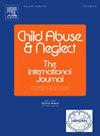Testing for bleeding disorders in child abuse: AAP recommendation adherence and testing results
IF 3.4
2区 心理学
Q1 FAMILY STUDIES
引用次数: 0
Abstract
Objectives
Using a multicenter child abuse pediatrics research network (CAPNET), the study objectives were to characterize the adherence to American Academy of Pediatrics (AAP) recommendations for bleeding disorder testing and the frequency of bleeding disorder identification.
Methods
We performed a descriptive study of bleeding disorder evaluations among children younger than 10 years of age who presented with bruising and/or intracranial hemorrhage (ICH) concerning for abuse from February 2021–May 2022 utilizing CAPNET. Cases were classified as bruising without ICH or ICH with or without bruising. Based on AAP guidance, testing was not recommended in cases with concomitant suspicious injuries, inflicted injury history, patterned injury, and low clinical concern for abuse. The primary outcome was adherence to AAP recommendations for testing by study group. We also calculated the frequency of bleeding disorder identification.
Results
A total of 2491 children presented with bruising and/or ICH concerning for abuse during the study period. 25.1 % of subjects (468 with bruising and 157 with ICH) were recommended to have testing by AAP criteria. Of these, 10.5 % cases of bruising and 33.1 % cases of ICH completed all AAP recommended testing. Among CAPNET centers, AAP recommended testing completion ranged from 0 to 34.1 % of bruising cases and 4.8–100 % of ICH cases. In total, 0.7 % (18/2491) cases had a newly identified bleeding disorder, with more identified at one center with higher testing rates.
Conclusions
Testing for bleeding disorders based on AAP recommendations frequently did not occur and varied by CAPNET center. Although rare, bleeding disorders were present among cases with testing.
儿童虐待中出血性疾病的检测:美国儿科学会推荐的依从性和检测结果
方法我们利用多中心儿童虐待儿科研究网络(CAPNET),对2021年2月至2022年5月期间出现瘀伤和/或颅内出血(ICH)并伴有虐待行为的10岁以下儿童的出血性疾病评估进行了描述性研究。病例分为无 ICH 的瘀伤或有或无瘀伤的 ICH。根据 AAP 指南,如果病例同时伴有可疑损伤、损伤史、模式化损伤以及虐待临床关注度较低,则不建议进行检测。主要结果是各研究组对 AAP 建议检测的遵守情况。我们还计算了识别出血性疾病的频率。结果 在研究期间,共有 2491 名儿童因瘀伤和/或 ICH 而被诊断为虐待。根据 AAP 标准,25.1% 的受试者(468 例瘀伤和 157 例 ICH)被建议进行检测。其中,10.5% 的瘀伤病例和 33.1% 的 ICH 病例完成了所有 AAP 建议的检测。在 CAPNET 中心中,AAP 建议的检测完成率在瘀伤病例的 0% 到 34.1% 之间,在 ICH 病例的 4.8% 到 100% 之间。总计有 0.7% 的病例(18/2491)新发现了出血性疾病,其中一个检测率较高的中心发现的出血性疾病更多。在接受检测的病例中,出血性疾病虽然罕见,但也存在。
本文章由计算机程序翻译,如有差异,请以英文原文为准。
求助全文
约1分钟内获得全文
求助全文
来源期刊

Child Abuse & Neglect
Multiple-
CiteScore
7.40
自引率
10.40%
发文量
397
期刊介绍:
Official Publication of the International Society for Prevention of Child Abuse and Neglect. Child Abuse & Neglect The International Journal, provides an international, multidisciplinary forum on all aspects of child abuse and neglect, with special emphasis on prevention and treatment; the scope extends further to all those aspects of life which either favor or hinder child development. While contributions will primarily be from the fields of psychology, psychiatry, social work, medicine, nursing, law enforcement, legislature, education, and anthropology, the Journal encourages the concerned lay individual and child-oriented advocate organizations to contribute.
 求助内容:
求助内容: 应助结果提醒方式:
应助结果提醒方式:


